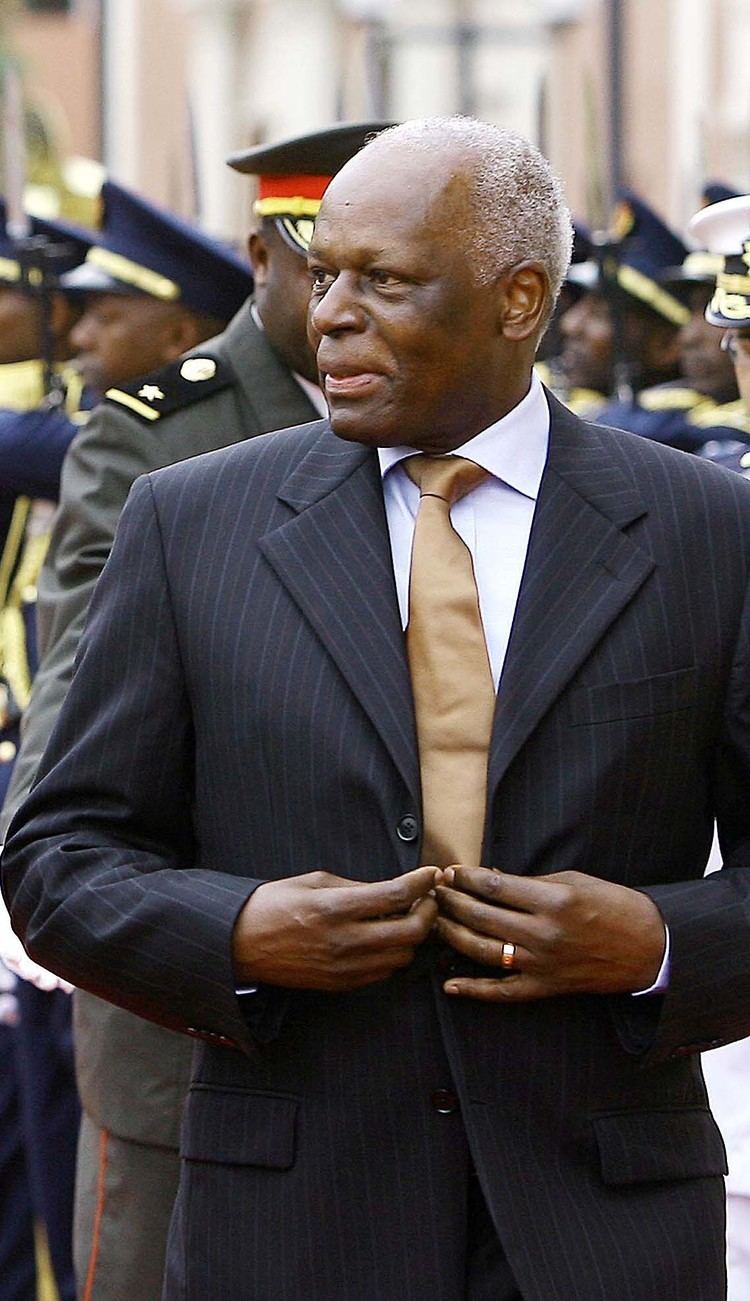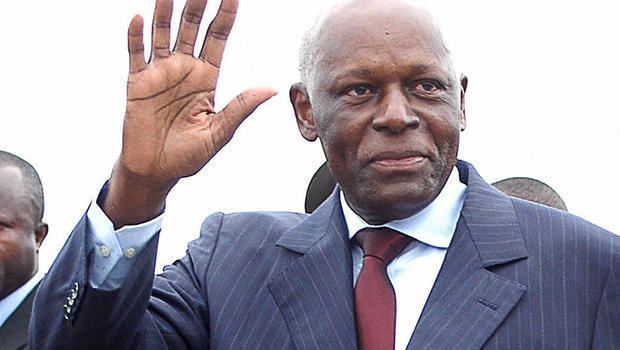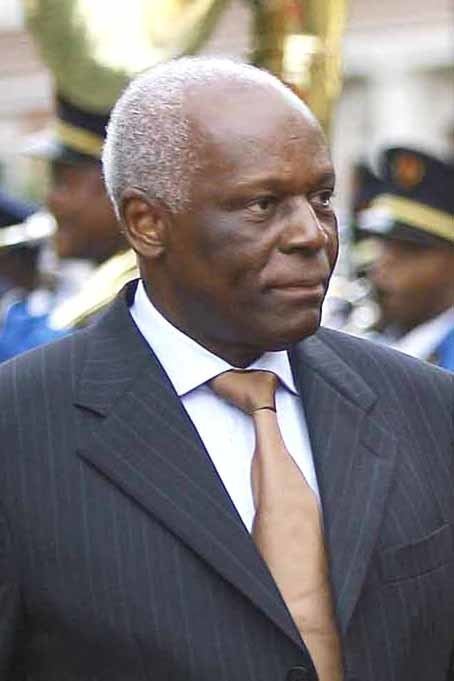Name Jose dos Grandchildren Carlitos Vieira Dias | ||
 | ||
Prime Minister Fernando Jose de Franca Dias Van-DunemMarcolino MocoFernando Jose de Franca Dias Van-DunemFernando da Piedade Dias dos SantosPaulo Kassoma Vice President Fernando da Piedade Dias dos SantosManuel Vicente Political party Popular Movement for the Liberation of Angola Alma mater Azerbaijan State Oil Academy Religion Roman Catholicism (Lapsed) Parents Jacinta Jose Paulino, Avelino Eduardo dos Santos Siblings Luis Eduardo dos Santos, Marta dos Santos, Avelino Eduardo dos Santos, Lucrecio Eduardo dos Santos Similar People | ||
Chinese president holds welcoming ceremony for angolan president jose eduardo dos santos
Jose Eduardo dos Santos (born 28 August 1942) is an Angolan politician who has been President of Angola since 1979. As President, Jose Eduardo dos Santos is also the commander in chief of the Angolan Armed Forces (FAA) and president of the People's Movement for the Liberation of Angola (MPLA), the party that has ruled Angola since it gained independence in 1975.
Contents
- Chinese president holds welcoming ceremony for angolan president jose eduardo dos santos
- Ex Angola president dos Santos quits last political post
- Early life and education
- Military service
- Early Political career
- Peace process
- Governance issues after end of civil war
- Contribution to economic development
- Controversial Issues
- Awards and recognitions
- Personal life
- References

Ex-Angola president dos Santos quits last political post
Early life and education

Eduardo dos Santos, born in what is today the district of Sambizanga in Luanda, is the son of Avelino Eduardo dos Santos, a stonemason, and Jacinta Jose Paulino, immigrants from Sao Tome and Principe in the Gulf of Guinea. He attended primary school in Luanda, and received his secondary education at the colonial elite school Liceu Salvador Correia, today called Mutu ya Kevela.
While studying in school, Jose Eduardo dos Santos joined the MPLA, which marked the beginning of his political career. Due to the repression by the colonial government, dos Santos went into exile in neighbouring Congo-Brazzaville in 1961. From there he collaborated with the MPLA and soon became an official member of the party. To continue with his education he moved, once again, to the Soviet Union, where by 1969, he received degrees in petroleum engineering and in radar communications from the Azerbaijan Oil and Chemistry Institute in Baku, Azerbaijan.
Military service

In 1970 he returned to Angola, which was still a Portuguese territory known as the Overseas Province of Angola played a significant role in the Angolan struggle for independence. He served for three years in the MPLA's guerrilla forces EPLA (Exercito Para a Libertacao de Angola) later to be known as the People's Armed Forces for the Liberation of Angola (FAPLA), a branch of the MPLA, becoming a radio transmitter in the second political-military region of the MPLA in Cabinda Province. In 1974, he was promoted to sub-commander of the telecoms service of the second region. He served as the MPLA's representative to Yugoslavia, the Democratic Republic of the Congo, and the People's Republic of China before being elected to the Central Committee and Politburo of the MPLA in Moxico in September 1974.
Early Political career
In June 1975, dos Santos became coordinator of the MPLA's Department of Foreign Affairs; he also coordinated the MPLA's Department of Health at this time. Upon Angolan independence in November 1975, the MPLA held power in Luanda, but the new MPLA government faced a civil war with the other political formations, the National Union for the Total Independence of Angola (UNITA) and the National Liberation Front of Angola (FNLA). The same year, Dos Santos was appointed as Angola's first Minister of Foreign Affairs upon independence, and in this capacity he played a key role in obtaining diplomatic recognition for the MPLA government in 1975–76. At the MPLA's First Congress in December 1977, Eduardo dos Santos was re-elected to the Central Committee and Politburo. In December 1978, he was moved from the post of First Deputy Prime Minister in the government to that of Minister of Planning.

After the death of Angola's first president, Agostinho Neto, on 10 September 1979, Jose Eduardo dos Santos was elected as President of the MPLA on 20 September 1979, and he took office as President of Angola, and Commander-in-Chief of the Armed Forces on 21 September. He was also elected as President of the People's Assembly on 9 November 1980.
Peace process
President dos Santos is considered to be a moderate Head of State, committed to bring peace to its country by continuing the economic and political reconstruction process initiated by his predecessor. The biggest issue he had to cope with was the ongoing conflict with its main rival liberation movement: the National Union for the Total Integration of Angola (UNITA). UNITA, led by Jonas Savimbi and supported by South Africa and the United States, never fully recognized the legitimacy of MPLA as the ruling government of Angola and triggered several armed conflicts over the years to express its opposition, which resulted in a 27-year civil war that ravaged the country and the Angolan public funds.
The war was also marked by intense foreign intervention, as the Soviet Union and Cuba backed MPLA and the US and South Africa supported Unita, as a way to limit the expansion of the Soviet influence in Africa.
On 29 and 30 September 1992, after 16 years of fighting that killed up to 300,000 people, elections were held in Angola, under the United Nations supervision. Jose Eduardo dos Santos won the election against his main rival, Jonas Savimbi (49.57% vs. 40.07%). A three-day war then started, during which the Halloween Massacre occurred, when tens of thousands of UNITA protestors were killed nationwide by MPLA forces. Savimbi then quit decided to give up the elections, alleging voting fraud, and immediately resumed the civil war, while Jose Eduardo dos Santos remained in office.
In 1993, while Savimbi and Unita refused to give up the territory won through battle, the United States, involved in settling peace talks between the two rival parties and leaders in order to work out a power-sharing arrangement, decided to withdraw their support to Unita and officially recognized dos Santos and the MPLA government as the official ruling-body in Angola.
The death of Unita’s leader Jonas Savimbi in February 2002 enabled the resumption of peace process. On April 4, the Angolan army and the rebels agreed to a ceasefire, and peace was officially declared on August 2. While recognized as an official political party by the Angolan government, UNITA agreed to demobilize its armed forces, made up of 50,000 fighters, and agreed for them to be reintegrated into the national security forces. Following that decision, the UN Security Council put the United Nations Office back in Angola and authorized the establishment of the United Nations Mission in Angola (UNMA), aimed at consolidating peace in the country.
Governance issues after end of civil war
In 2001, dos Santos announced that he would step down at the next presidential election. However, in December 2003 he was reelected as head of the MPLA and no further presidential election took place, despite these being announced for 2006, then 2007 and finally announced that the next presidential election would be held in 2009. After a legislative election in 2008 in which the ruling MPLA won a landslide victory, the party started working on a new constitution that was introduced early in 2010. Under the terms of the new constitution, the leader of the party with the most seats in Parliament automatically becomes the president of the country.
Jose Eduardo dos Santos reportedly escaped an assassination attempt on 24 October 2010 when a vehicle tried to intercept his car as he was returning from the beach with his family. His escort opened fire killing two passengers in the vehicle, and weapons were found on board. This incident has not been confirmed by any other source. In February/March 2011, and then again in September 2011, public manifestations were organized in Luanda by young Angolans, mostly via the Internet.
In the 2012 general election, his party, the MPLA, won more than two-thirds of the votes. As dos Santos had been the top candidate of the party, he automatically became the President of the Republic, in line with the constitution adopted in 2010.
In September 2014, Jose Eduardo dos Santos announced the end of the cumulation of the position of provincial governor with provincial first secretary of MPLA. This measure aimed to improve the operation of the provincial administration and the municipal administrations, as a way to adjust the governance model to a new context and bigger demand for public services.
Contribution to economic development
As president, dos Santos continued the task of economic and political reconstruction begun by his predecessor.
In the early 1990s, dos Santos progressively abandoned the Marxist ideology and established a liberalised free-market economy in Angola, setting the country on the path to becoming sub-Saharan Africa’s third largest economy, following South Africa and Nigeria, the second largest African oil producer and a top destination for foreign investment in Africa.
In November 2006, dos Santos cofounded the African Countries diamond Producers Association, an organization of approximately 20 African nations founded to promote market cooperation and foreign investment in the African diamond industry.
Jose Eduardo dos Santos’s role in the development of the oil sector was praised in London, during the opening of the first annual world conference to support the national business sector, which was held in October 2014. The name of the Angolan President was hailed for his commitment in the integration of the national entrepreneurship in the sector and staff training, as well as for his incentive towards young people’s training in technical areas, namely in Petroleum Engineering.
The role of the President Jose Eduardo dos Santos, in the growth of the Angolan economy, was the topic of a lecture held on August 28. The Angolan economist Jose Pedro de Morais, the lecturer, stressed the various pragmatic steps taken by the Angolan Head of State, in all stages of the complex context of the country. According to the speaker, President Jose Eduardo dos Santos has always had to solve complex problems in the leadership of the country's destiny, ranging from war to the pacifying of the spirits of citizens and through economic and political stabilization.
Controversial Issues
Dos Santos has been accused of leading one of the most corrupt regimes in Africa by ignoring the economic and social needs of Angola and focusing his efforts on amassing wealth for his family and silencing his opposition, while, nearly 70% of the population lives on less than $2 a day.
Dos Santos became wealthy when he first took power, but only began amassing his incredibly large assets during and after the Angolan civil wars. When the ceasefire occurred and large portions of the economy were being partially privatized, he took control of several emerging companies and industries. He helped arrange similar takeovers of several other natural resource industries.
Eventually the Angolan Parliament made it illegal for the president to have financial holdings in companies and organizations. In response to this, Dos Santos supposedly began arranging for his daughter to receive the financial kickbacks and assets from these companies. Dos Santos then began using the government to take direct control of stakes in companies offered as kickbacks which he indirectly controlled and reaped the benefits ofand managed to retain large corporate assets through proxies.
Along with this, the government budget had grown over a decade to 69 billion dollars in 2012 through oil revenues. The International Monetary Fund reported that 32 billion in oil revenue simply went missing from the government’s ledger before being tracked to have been used on “quasi-fiscal activities”.
Awards and recognitions
Jose Eduardo dos Santos was named "Man of the Year 2014" by Africa World magazine. According to the newspaper, the choice of the Angolan leader is due to his contribution to the great process of economic and democratic recovery of Angola since the end of the war.
Dos Santos was praised for the major role he played in favour of the country’s independence, and his commitment to the promotion of peace and democracy in the country, through negotiations with oppositions movements designed to put a definite end to the civil war.
Personal life
Jose Eduardo dos Santos married three times and has six children from his wives, and one born out of wedlock. He is currently married to former fashion model and air hostess Ana Paula dos Santos. He and his family have amassed a significant personal fortune.
